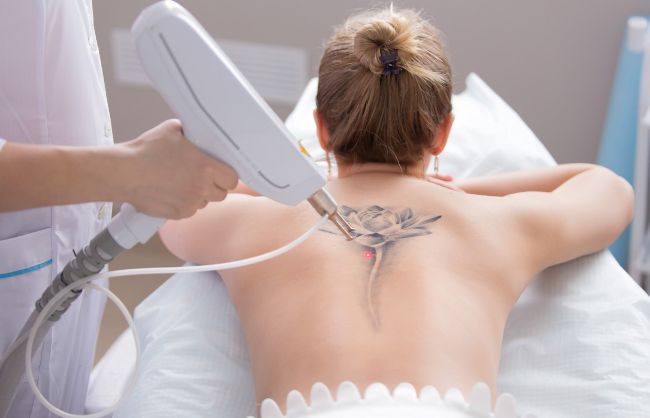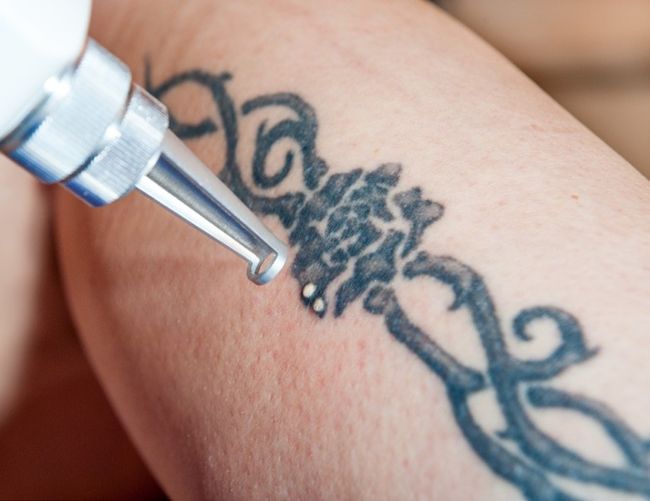TATTOO REMOVAL
What happens when you don’t ‘think before you think’? BEFORE YOU INK?
We asked the experts from Aesthetic Laser Academy to answer all your questions about tattoo removal treatments

:Image from Shutterstock
"THE BIGGEST INFLUENCE
on the number of
TREATMENTS REQUIRED
is the
CLIENT’S IMMUNE SYSTEM,
which is dictated by their
LIFESTYLE, AGE, GENETICS
and
HEALTH.
Without naming any brands, what type of laser technologies are most suited to tattoo removal?
Of all the lasers available, NDYag O-switch Laser is known to cause very little, if any, scarring. In our experience, it is the best technology to use for tattoo removal and removal of permanent make-up / microblading. PICO laser is considered to be faster than ND Yag. A fibroblast Plasma Pen can be used to remove small, non-professional tattoos.
How does the laser beam work to remove tattoo ink?
The NDYag laser uses excessive, controlled, heat, speed and light to fragment the tattoo into more manageable, smaller pieces so that the white blood cells can take these pieces to the lymphatic system to eventually be excreted by the excretory system. Like the meme says – ‘You’re going to poop out your tattoo!’
What are the contraindications for tattoo removal?
Contraindications are: pregnancy; epilepsy; retinoids; photo dynamic therapy; steroids; and UV tattoo.
Are all skin types eligible for tattoo removal, or is this something the darker Fitzpatrick skin types should avoid?
Tattoo removal is certainly suited to every skin type and doesn’t need to be avoided by the darker skin types.
However, darker skin colour needs to be treated with extra caution.
Typically – how many sessions would be necessary to remove, for example, a smallish tattoo?
The biggest influence on the number of treatments required is the client’s immune system, which is dictated by their lifestyle, age, genetics and health.
A small tattoo (3cm) in size, takes on average at least 4 months / treatments to remove.We use the Kirby Desai Scale to provide the client with a guesstimate. In the Kirby Desai Scale, numerical values are assigned to six parameters – skin type, location on the body, colour of tattoo, amount of ink, scarring, and layering.
What, typically, is the suggested interval between treatments?
We highly recommend treatment intervals of 28 days, as all the scabs need to be healed by the time they return for the next treatment, in order to avoid the risk of scarring.
What procedure should the aesthetician/ laser operator follow?
The client undergoes a thorough consultation with the therapist, finding out about health issues, previous treatments, medications the client is on, as well as assessing the tattoo itself; how much ink is in it, how old the tattoo is, how many layers there are to the tattoo, etc. The therapist will then do a skin sensitivity test (including tactile & thermal tests) to assess the client’s ability to feel pain. The last step to consultation is a patch test – the client needs to come in one week before their first treatment, where the therapist shoots 20 shots per colour on the tattoo and the client then has to record any adverse reactions to treatment.
How should the operator move the laser beam across the tattoo?
The operator needs to shoot shots at a 90 degree angle, directly next to each other to ensure that the whole tattoo has been treated. We also prefer to work logically, therefore we will start at a point and finish the whole tattoo rather than shooting a few shots here and the next shots on the other side of the tattoo. The ND YAG laser machine has interchangeable filters (532nm and 1064nm), which are used for different colours in the tattoo.

Image from Shutterstock
"COLOUR INK
is much more
CHALLENGING TO REMOVE
than normal black ink as
BLACK INK CAN ABSORB
all of the
WAVELENGTHS
released by
THE LASER,
whereas colour ink cannot."
How can you make the treatment more bearable for the patient?
The client is encouraged to take a few steps to minimize discomfort especially if their pain tolerance is low. They can take pain tablets, cold compress or anaesthetic creams. For some people, it’s even more painful than getting the tattoo.
Is each session of a tattoo removal treatment fairly short because of patient discomfort?
That is correct. The treatment time for small tattoo (3cm) is around 10 minutes. We try to minimize client discomfort by keeping sessions short, as well as pausing in between a few shots for the skin to relax.
Are there particular shades of ink that are more stubborn to remove than others?
Colour ink is much more challenging to remove than normal black ink. This is because black ink can absorb all of the wavelengths released by the laser, whereas colour ink cannot absorb all wavelengths and is more stubborn to remove. White, yellow and UV ink cannot be removed completely.
Post treatment – what can the patient expect?
The area will be painful, swollen, red and sensitive to sunlight and other forms of heat. The area may also present with blisters, pin point bleeding and some frosting. A few days after treatment, the treated area will undergo different stages of healing, including bruising, oozing, scabbing, more blisters, itchiness and hypopigmentation. The area will remain tender until all scabs are healed.
Is there a danger of the patient’s skin scarring?
ND YAG is a level 4 and ablative laser, so there is always a risk of damage to the client’s skin. This risk can be reduced by a well-trained therapist and proper client education and after care instructions. The client can also prevent scarring by not picking at scabs. Formation of keloids on the treated area is another risk, but this too can be managed.
What after-care do you recommend for the patient?
The client has a few steps that they can take for after care. Firstly, the client has to avoid direct sunlight as well as any form of heat (like hot showers and saunas) on the treatment area. The client also needs to avoid products containing alcohol or chemical properties. Furthermore, the client can’t use anti-bacterial soap as we still need the good bacteria found in the skin to help heal the wound. They also need to remember to use a sunscreen when going into the sun for extra protection against sun damage on the treated area. Clients can use aloe vera gel or other forms of natural products to help ease discomfort during the healing process. The client cannot cover the wound with any sort of bandage, or apply make-up as the wound needs to follow a dry healing process.
A good ND YAG laser machine will also have a 1320nm filter which is used for Carbon laser facials, also known as Hollywood Facials / Charcoal facials. It can also be used to reduce acne, scarring, pigmentation, spider veins and nail fungus.
Which other methods are available for tattoo removal?
Laser treatments; dermabrasion (i.e. sanding the skin); salabrasion (i.e. scraping the skin with water and salt); chemical peels, acids and injections; surgical excision; creams containing chemicals and acids; tattoo scar correction (i.e. cover up tattoos); and cryo treatments, similar to mole removal.
What legislation pertains to tattoo removal machines and operators?
Legislation requires that every person operating the equipment (as well as the equipment itself) has to be registered with the Department of Health – Directorate: Radiation Control. Suppliers of equipment need to be registered with the Directorate and licensed to import any electromedical device. Laser devices fall under the Hazardous Substances Act, 1973 (Act 15 of 1973). Enquiries: Tel: 021 - 948 6162
The Aesthetic Laser Academy is committed to providing the most comprehensive aesthetic laser skills training in SA, both in person and online, since inception in 2017. www.laseracademy.co.za